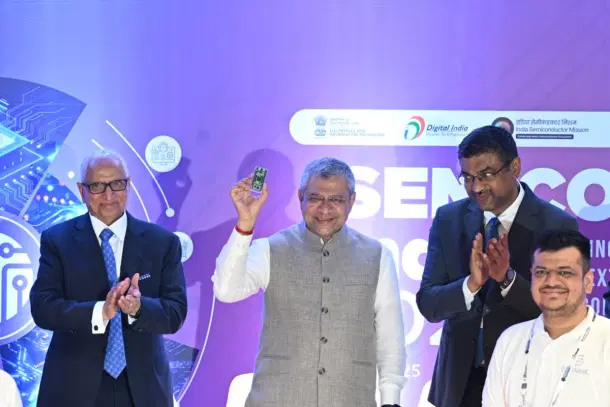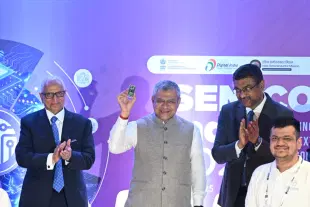News Brief
Semicon India 2025: Indian Startups Showcase Indigenous Chip Designs Across Sectors
Swarajya Staff
Sep 04, 2025, 04:46 PM | Updated 04:55 PM IST
Save & read from anywhere!
Bookmark stories for easy access on any device or the Swarajya app.


Semicon India 2025 at Yashobhoomi in New Delhi showcased the growing work of Indian startups in semiconductor design under the government’s Design Linked Incentive (DLI) Scheme.
The event featured roadmaps for indigenous System-on-Chip (SoC) solutions for broadband, surveillance, smart energy meters, motor control, and space applications, reflecting India’s ambition of becoming a full-stack semiconductor nation.
Prime Minister Narendra Modi visited the exhibition stalls along with Minister of Electronics and Information Technology Ashwini Vaishnaw and Minister of State Jitin Prasada on the second day of the Semicon India 2025 on Wednesday (3 September).
During the visit, the Prime Minister emphasised the pivotal role of startups in building India’s semiconductor capability and the importance of creating domestic intellectual property.
According to the Ministry of Electronics & IT, 23 chip design projects have already been sanctioned under the government's DLI Scheme and 72 companies now have access to industry-grade Electronic Design Automation (EDA) tools, enabling them to advance their chip design work.
Many of these startups showcased their roadmaps at Semicon India 2025, reflecting India's growing capability and self-reliance in semiconductor chip design.
A major highlight was InCore Semiconductors, founded by the creators of the SHAKTI processors, which showcased its RISC-V based SoC Generator Platform.
The platform is designed to reduce frontend chip design time from months to minutes, lowering costs and design risks.
A test chip fabricated on TSMC’s 40nm process node demonstrated six heterogeneous RISC-V cores, a custom Network-on-Chip, integrated peripherals, and a real-time operating system.
InCore also presented its processor families: Azurite for ultra-low power devices and motor control, Calcite for IoT and camera applications, and Dolomite, still in development, for networking and edge AI.
Aheesa Digital Innovations presented details of its Vihaan SoC, built on the C-DAC VEGA processor, which will be made available to OEMs and ODMs in 2026, enabling them to develop custom networking and broadband solutions using a 100 per cent indigenously designed, Made-in-India SoC.
The design includes Secure Boot, PCIe 3.0, USB 3.0, and other connectivity features for broadband and networking solutions.
Four companies — 3rdiTech, Netrasemi, BigEndian Semiconductors, and Mindgrove Technologies — showcased their indigenous SoC designs for surveillance and CCTV applications.
All four have completed test chips in 2025 and are targeting production-grade variants in 2026.
Collectively, they have raised more than Rs 300 crore and reached a combined valuation exceeding Rs 1,000 crore.
Vervesemi presented its roadmap for SoCs in motor control, EVs, drones, and weighing systems, with production targeted between late 2026 and 2027.
The company is also collaborating with ISRO on space-grade ASICs to replace imported components, with engineering samples expected between 2025 and 2026.
In telecom, MBit Wireless displayed its indigenously developed 4G-LTE modem chipset, complete with protocol stack software.
The chipset has been certified by the Global Certification Forum and LG labs and is currently undergoing field trials with Indian telecom operators.
Please click here to add Swarajya as your preferred and trusted news source on Google.




